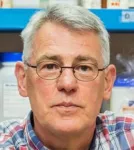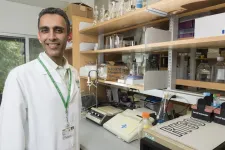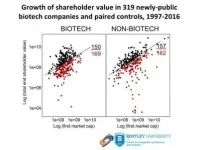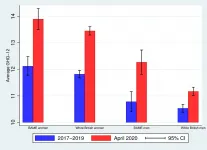(Press-News.org) Indianapolis, Ind. - A team of researchers led by the Indiana Biosciences Research Institute Diabetes Center's Scientific Director Decio L. Eizirik, MD, PhD, has found that identifying new treatments for autoimmune diseases requires studying together the immune system AND target tissues. This study, "Gene expression signatures of target tissues in type 1 diabetes, lupus erythematosus, multiple sclerosis and rheumatoid arthritis," is featured in the Jan. 6, 2021, edition of Science Advances.
"We must move away from the present "immune-centric-only" view of autoimmune diseases," explains Eizirik. "Indeed, trying to understand these diseases focusing on the immune system only, and forgetting the target tissues, may be similar to attempting to fly a plane with only one wing."
Autoimmune diseases, which affect up to 5 percent of the population in different regions, suffer from a case of mistaken identity. The immune system is supposed to protect us from infectious diseases or tumors. Yet, during autoimmune diseases the immune system mistakenly attacks and destroys components of our body, which then causes, for example, type 1 diabetes (T1D), systemic lupus erythematosus (SLE), multiple sclerosis (MS) or rheumatoid arthritis (RA). These four autoimmune diseases share almost half of the same genetic risks, chronic local inflammation and mechanisms leading to target tissue damage.
Despite these common features, autoimmune disorders are traditionally studied independently and with a focus on the immune system rather than on the target tissues. Knowing that there is increasing evidence that the target tissues of these diseases are not innocent bystanders of the immune system attack, but instead are active participants, Eizirik and his team hypothesized that key inflammation-induced mechanisms, potentially shared between T1D, SLE, MS and RA, may drive similar molecular signatures at the target tissue level.
"This research is significant in reaching the JDRF's mission to cure, treat and prevent T1D," said Frank Martin, Ph.D., JDRF director of research. "Discovering the common pathways of tissue destruction across multiple autoimmune diseases will dramatically accelerate our path to a cure for T1D. Drugs that are effective in one autoimmune disease could be equally beneficial for another and quickly repurposed to make a big impact for people living with that disease. Characterizing the similarities and differences between multiple autoimmune diseases has the potential to transform the way we treat and cure these diseases in the future."
To test this hypothesis, the research team obtained gene expression data from diseased tissue sampled from controls or individuals affected by T1D, SLE, MS and RA. This indicated major common gene expression changes at the target tissues of the four autoimmune diseases evaluated. One candidate gene in common between the four diseases is TYK2, a protein that regulates interferon signaling. The team showed in its research that use of TYK2 inhibitors - already in use for other autoimmune diseases - protect β-cells against immune-mediated damage. This finding reinforces the importance of studying the target tissue of autoimmune diseases, in dialogue with the immune system, to better understand the genetics and natural history of these devastating diseases and to identify novel therapies.
The authors of this study include:
Decio L. Eizirik, Indiana Biosciences Research Institute, Indianapolis, IN, USA and Université Libre de Bruxelles, Brussels, Belgium
Florian Szymczak, Université Libre de Bruxelles, Brussels, Belgium
Maikel Colli, Université Libre de Bruxelles, Brussels, Belgium
Mark Mamula, Yale University School of Medicine, New Haven, USA
Carmella Evans-Molina, Indiana University School of Medicine, Center for Diabetes and Metabolic Diseases, Indianapolis, IN, USA
INFORMATION:
About the Indiana Biosciences Research Institute
The Indiana Biosciences Research Institute (IBRI) is an independent, nonprofit discovery science and applied research institute currently targeting diabetes, metabolic disease, poor nutrition and related health data science. Inspired by Indiana's leading life sciences companies, research universities and philanthropic community, the IBRI is building a world-class organization of researchers, innovators and entrepreneurs to catalyze scientific discovery and its applications, resulting in improved health outcomes for Indiana patients and beyond. For more information about the IBRI, visit https://www.indianabiosciences.org/.
About JDRF
JDRF's mission is to accelerate life-changing breakthroughs to cure, prevent, and treat T1D and its complications. To accomplish this, JDRF has invested more than $2.5 billion in research funding since our inception. We are an organization built on a grassroots model of people connecting in their local communities, collaborating regionally for efficiency and broader fundraising impact and uniting on a national stage to pool resources, passion and energy. We collaborate with academic institutions, policymakers and corporate and industry partners to develop and deliver a pipeline of innovative therapies to people living with T1D. Our staff and volunteers throughout the United States and our five international affiliates are dedicated to advocacy, community engagement and our vision of a world without T1D. For more information, please visit jdrf.org or follow us on Twitter: @JDRF
Researchers at Rush University Medical Center have found that opioid use might increase a person's risk of developing pancreatic cancer.
Published Jan. 6, the study, titled "Opioid Use as a Potential Risk Factor for Pancreatic Cancer in the United States," is the first in the country to show evidence that opioid use may be an unidentified risk factor contributing to the increasing incidence of pancreatic cancer.
In fact, opioid misuse and overdose have evolved into a public health crisis. Approximately 70,000 drug overdose deaths were reported in 2017, 68% of which involved an opioid.¹ The use of prescription opioids for the management of chronic pain ...
DURHAM, N.C. -- Before the pandemic, one-third of U.S. households with children were already "net worth poor," lacking enough financial resources to sustain their families for three months at a poverty level, finds new research from Duke University.
In 2019, 57 percent of Black families and 50 percent of Latino families with children were poor in terms of net worth. By comparison, the rate for white families was 24 percent.
"These 'net worth poor' households have no assets to withstand a sudden economic loss, like we have seen with COVID-19," said Christina Gibson-Davis, co-author of the study and professor of public policy and sociology at Duke University's Center for Child and Family Policy. "Their ...
Related to new research published in the January issue of Science Translational Medicine, Patrick McNutt, PhD, of the Wake Forest Institute for Regenerative Medicine, was part of the research team that demonstrated a new "Trojan horse" approach that produces strong antidotal efficacy in treating lethal botulism in mice, guinea pigs and rhesus macaque monkeys.
Furthermore, in a companion article, an independent team demonstrated that a related drug has robust efficacy in mice.
"This is one of those serendipitous moments in science where two groups, working independently, demonstrate similar results for a long-standing ...
Investing in biotech companies may not entail higher risk than investing in other sectors, according to a new report from Bentley University's Center for Integration of Science and Industry. A large scale study of biotechnology companies that completed Initial Public Offerings (IPOs) from 1997-2016 demonstrates that these companies produced more than $100 billion in shareholder value and almost $100 billion in new value creation despite a failure rate greater than 50%. The study compared the financial performance and economic value created by these biotech companies to non-biotechnology controls that had similarly timed IPOs.
The findings are published in PLOS ONE in the article "Comparing long-term value creation after biotech and non-biotech ...
Our reluctance to think, talk or communicate about death is even more pronounced when we deal with others' loss compared to our own, new research finds, but either way we tend to frame attitudes and emotions in a sad and negative way.
Teaching new more positive ways to address these difficult conversations is the focus of a new paper in PLOS ONE journal by palliative care specialists across Australia.
Led by Flinders University's Research Centre for Palliative Care, Death and Dying (RePaDD) and Palliative and Supportive Services, researchers from Flinders, CQUniversity Australia, NT Palliative Care Central Australia and University of Technology Sydney, surveyed 1,491 people about ...
Photosynthetic organisms tap light for fuel, but sometimes there's too much of a good thing.
New research from Washington University in St. Louis reveals the core structure of the light-harvesting antenna of cyanobacteria or blue-green algae -- including key features that both collect energy and block excess light absorption. The study, published Jan. 6 in Science Advances, yields insights relevant to future energy applications.
Scientists built a model of the large protein complex called phycobilisome that collects and transmits light energy. Phycobilisomes allow cyanobacteria to take advantage of different wavelengths of light than other photosynthetic ...
An analysis of 145 scholarly journals found that, among various factors that could contribute to gender bias and lesser representation of women in science, the peer review process itself is unlikely to be the primary cause of publishing inequalities. However, Flaminio Squazzoni and colleagues emphasize that the study does not account for many other factors that may affect women's representation in academia, including educational stereotypes and academic choices of priorities and specialties. Even as female representation has improved in fields such as the humanities, psychology, and the social sciences, a publication gap persists, with male authors continuing to publish more manuscripts in more prestigious journals. To better understand whether ...
Step into your new, microscopic time machine. Scientists at the University of Colorado Boulder have discovered that a type of single-celled organism living in modern-day oceans may have a lot in common with life forms that existed billions of years ago--and that fundamentally transformed the planet.
The new research, which will appear Jan. 6 in the journal Science Advances, is the latest to probe the lives of what may be nature's hardest working microbes: cyanobacteria.
These single-celled, photosynthetic organisms, also known as "blue-green algae," can be found in almost any large body of water today. But more than 2 billion years ago, they took on an extra important role in the history of life on ...
In the UK, men from ethnic minorities and women may have experienced worse mental health declines than White British men, according to a study published January 6, 2021 in the open access journal PLOS ONE by Eugenio Proto and Climent Quintana-Domeque of institutions including the University of Glasgow and the University of Exeter, UK.
The COVID-19 pandemic, and the measures enacted to restrict the spread of the virus, have had a major impact on the lives of citizens globally. The authors of the present study examined changes in mental health associated with the pandemic across ethnic groups in the UK.
The researchers used data from the UK Household Longitudinal Study, comparing responses from participants between 2017 and 2019 (i.e.: prior to the pandemic) to responses from ...
CAR T cells are a breakthrough class of effective but often toxic cancer therapies
To prevent overactivation, switchable CAR T cells were engineered that can be turned on and off with an approved, widely used cancer drug
BOSTON - Scientists at Dana-Farber Cancer Institute and Mass General Cancer Center have created molecular ON-OFF switches to regulate the activity of CAR T cells, a potent form of cell-based immunotherapy that has had dramatic success in treating some advanced cancers, but which pose a significant risk of toxic side effects.
CAR T cells are immune cells genetically modified to recognize and attack tumors ...




